Database
Setup
PHPMaker can connect to MySQL, PostgresSQL, Microsoft SQL Server, Oracle and SQLite. Click the  icon in the toolbar to go to Database tab.
icon in the toolbar to go to Database tab.
Notes
- This article discusses connection to your database by PHPMaker, NOT by PHP. After being generated, the scripts connect to database by PHP and its database drivers on your web server, which can be a completely different environment. For example, you may connect to your local database on your Windows PC with PHPMaker, but you may upload the generated scripts to your production Linux web server and the production database server may not be installed on the same server.
- If you have a development database server installed locally on the same computer that PHPMaker is installed, then you probably use "localhost" as server name when you connect to it with PHPMaker. After being uploaded to the production server, the generated scripts will try to connect to the production database server using the same connection info. If the production database server uses different info, the connection will fail. You can use either Database_Connecting server event (see Server Events and Client Scripts) or the advanced setting Connection info of production server (JSON) (see Advanced Settings) to change the connection information during runtime.
MySQL
Select MySQL as database type. Note that MySQL 4.1 and older (or MariaDB 10.1 and older) are NOT supported.
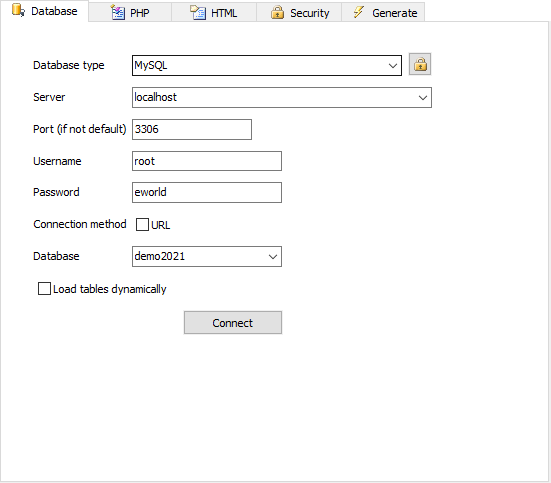
There are 2 connection methods
you can choose:
Direct Connection (default)
- Enter your database host/server name (or IP address), username, password
and port number (default is 3306 for MySQL),
- Select your database,
- Click the Connect button to load the database information.
Encrypted Connection
From v2021 PHPMaker supports encrypted connection to MySQL server. If you have configured your MySQL server to use encrypted connection, you can click the  button (next to the Database type setting) and enter the additional connection options:
button (next to the Database type setting) and enter the additional connection options:
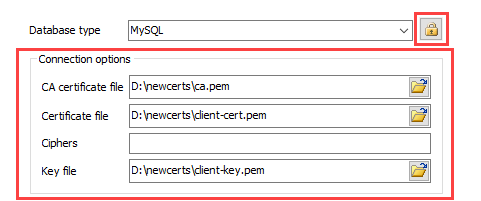
The options are:
- CA certificate file - The path name of the Certificate Authority (CA) certificate file.
- Certificate file - The path name of the client public key certificate file.
- Ciphers - The list of permissible ciphers for connection encryption. Optional, usually you can leave it blank.
- Key file - The path name of the client private key file.
Note Since these options are usually different on the production server, you must use Database_Connecting server event (see Server Events and Client Scripts) or the advanced setting Connection info of production server (JSON) (see Advanced Settings) to set additional connection information during runtime, see Connection Details for mysqli and pdo_mysql.
URL Connection (for remote database)
(Also see Tutorial - Connecting Remote MySQL using PHPMaker
Connection Script)
While the direct connection method is quick and easy, some remote MySQL
server may not allow direct connection. PHPMaker provides
an alternative simple way to connect remote servers:
- Upload the tunnel.php provided by PHPMaker to your site.
The tunnel.php can be found
under your installed folder, usually C:\Program Files (x86)\PHPMaker <version>\.
- Enter your connection information, select URL for
connection method, enter the URL of the script (e.g. https://servername/path/tunnel.php),
you can test the URL by clicking the Test button,
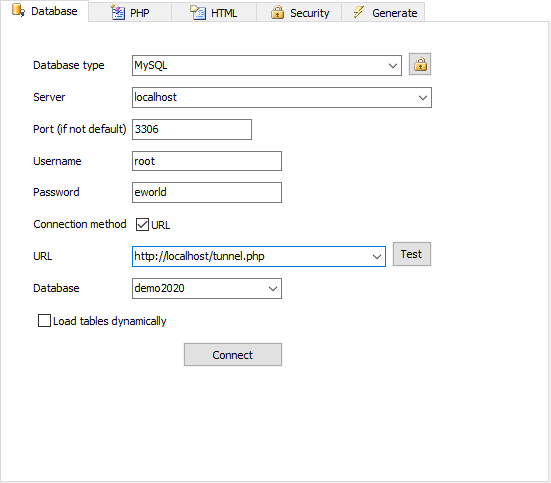
- Click the Connect button to load the database information.
PHPMaker will connect to the database server through the PHP script
over HTTP.
Notes
- Remote connection is slow, you should use URL connection ONLY IF you cannot create the same database in your development environment.
- You may need to create user in your database as 'username'@'%', the wildcard as host implies that the user can connect from any client host.
- If the MySQL server is not installed on the web server (e.g. hosting providers may use separate MySQL servers), then the server is not "localhost", you should enter the IP address of the MySQL server.
- The URL connection method does not support encrypted connection.
PostgreSQL
Select PostgreSQL as database type. Note that PostgreSQL 9.3 and older are NOT supported.

There are 2 connection methods
you can choose:
Direct Connection (default)
- Enter your database host/server name (or IP address), username, password
and port number (default is 5432 for PostgreSQL),
- Select your database,
- Click the Connect button to load the database information.
Encrypted Connection
From v2021 PHPMaker supports encrypted connection to PostgreSQL server. If you have configured your PostgreSQL server to use encrypted connection, you can click the  button (next to the Database type setting) and enter the additional connection options:
button (next to the Database type setting) and enter the additional connection options:
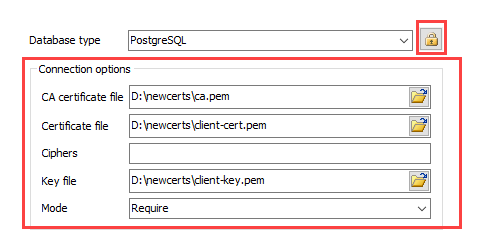
The options are:
- CA certificate file - The path name of the Certificate Authority (CA) certificate file.
- Certificate file - The path name of the client public key certificate file.
- Ciphers - The list of permissible ciphers for connection encryption. Optional, usually you can leave it blank.
- Key file - The path name of the client private key file.
- Mode - SSL mode (see SSL Mode Descriptions for details).
Note Since these options are usually different on the production server, you must use Database_Connecting server event (see Server Events and Client Scripts) or the advanced setting Connection info of production server (JSON) (see Advanced Settings) to set additional connection information during runtime, see Connection Details.
URL Connection (for remote database)
Similar to above for MySQL.
Note The URL connection method does not support encrypted connection.
Microsoft SQL Server
- Select Microsoft
SQL Server as database type,
- Enter the name or IP of the SQL server, (if the server name includes an instance name, e.g. localhost/SQLEXPRESS, make sure you include it)
- Enter the Username and
Password,
- Select the database you want or
just enter the name of your database,
- Click the
 Connect button to load the database information.
Connect button to load the database information.
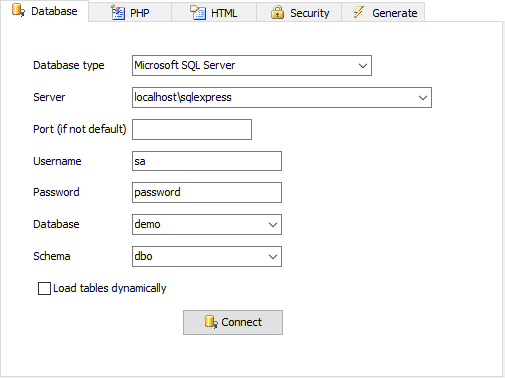
Oracle
Notes
- From v2021 PHPMaker can connect to Oracle database with or without Oracle client installed on your computer.
- If you prefer using Oracle TNS name (e.g. "XE"), you should use Oracle client (x86) which you can from the Oracle website. Make sure the path of your Oracle client (e.g. oci.dll) is among the Path variable under Windows Environment Variables -> System variable.
- If you prefer direct connection to Oracle database without Oracle client, then you need to enter the TNS name in the format of host:port/service_name, e.g. "localhost:1521/XE". However, note that PHP oci8 extension still need Oracle client to connect. Therefore, if you test the scripts locally on your PC, you still need to install Oracle client.
- Select Oracle as database type,
- Enter the Oracle TNS name,
- Enter the Username and
Password,
- Select the Schema you want or
just enter the Schema name,
- Click the
 Connect button to load the database information.
Connect button to load the database information.

SQLite
- Select SQLite as database type,
- Select the SQLite database
file by clicking the
 button,
button,
- Specify the
database path where the database file will reside under the your project folder,
- Click the
 Connect button to load the database information.
Connect button to load the database information.
Note Database path is relative to project folder. Use slashes "/" as path delimiter, no leading slash. e.g. If the project folder of your website is D:\websites\demo and you enter "data/" in this textbox, the folder for the database will be D:\websites\demo\data.
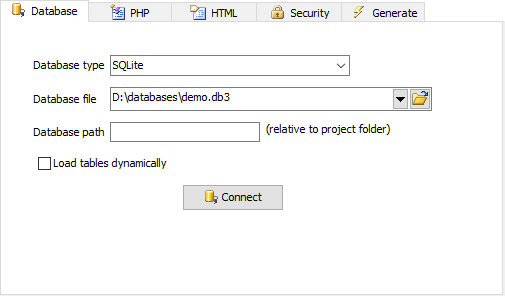
Dynamic Table Loading
By default all tables in the database are loaded. It is convenient but loading and sychronization could be slow if your database contains a large number of tables or fields. If this option is enabled, a table will only be loaded when you select it in the database pane. If you just use a few tables out of a large database, this feature enables you to work much faster than before. To enable this feature, simply check Load tables dynamically BEFORE pressing the Connect button.


![]() icon in the toolbar to go to Database tab.
icon in the toolbar to go to Database tab. 
![]() button (next to the Database type setting) and enter the additional connection options:
button (next to the Database type setting) and enter the additional connection options:


![]() button (next to the Database type setting) and enter the additional connection options:
button (next to the Database type setting) and enter the additional connection options:


